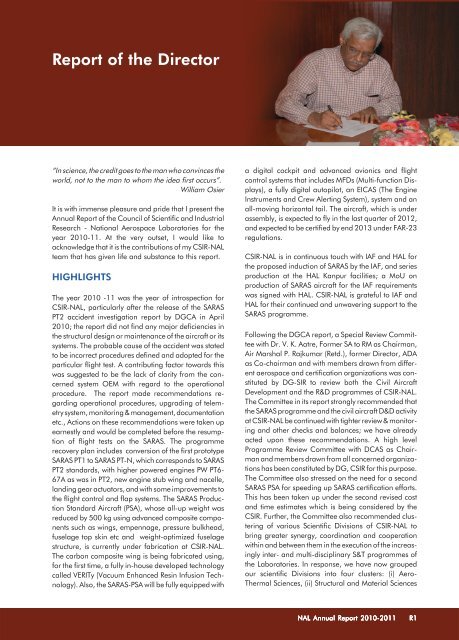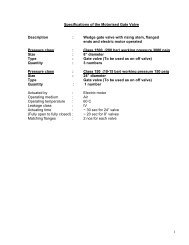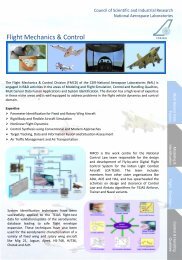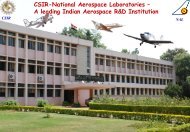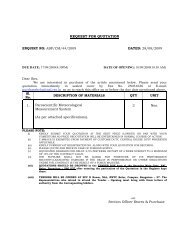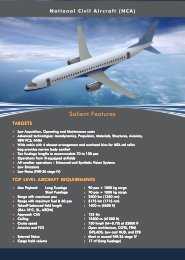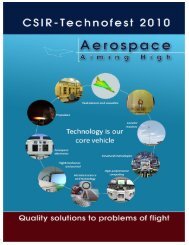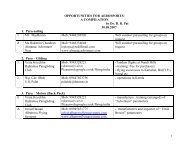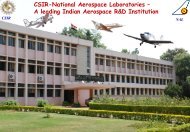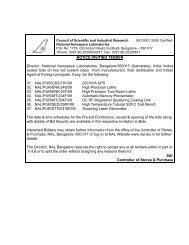Report of the Director - National Aerospace Laboratories
Report of the Director - National Aerospace Laboratories
Report of the Director - National Aerospace Laboratories
You also want an ePaper? Increase the reach of your titles
YUMPU automatically turns print PDFs into web optimized ePapers that Google loves.
<strong>Report</strong> <strong>of</strong> <strong>the</strong> <strong>Director</strong><br />
“In science, <strong>the</strong> credit goes to <strong>the</strong> man who convinces <strong>the</strong><br />
world, not to <strong>the</strong> man to whom <strong>the</strong> idea first occurs”.<br />
William Osier<br />
It is with immense pleasure and pride that I present <strong>the</strong><br />
Annual <strong>Report</strong> <strong>of</strong> <strong>the</strong> Council <strong>of</strong> Scientific and Industrial<br />
Research - <strong>National</strong> <strong>Aerospace</strong> <strong>Laboratories</strong> for <strong>the</strong><br />
year 2010-11. At <strong>the</strong> very outset, I would like to<br />
acknowledge that it is <strong>the</strong> contributions <strong>of</strong> my CSIR-NAL<br />
team that has given life and substance to this report.<br />
HIGHLIGHTS<br />
The year 2010 -11 was <strong>the</strong> year <strong>of</strong> introspection for<br />
CSIR-NAL, particularly after <strong>the</strong> release <strong>of</strong> <strong>the</strong> SARAS<br />
PT2 accident investigation report by DGCA in April<br />
2010; <strong>the</strong> report did not find any major deficiencies in<br />
<strong>the</strong> structural design or maintenance <strong>of</strong> <strong>the</strong> aircraft or its<br />
systems. The probable cause <strong>of</strong> <strong>the</strong> accident was stated<br />
to be incorrect procedures defined and adopted for <strong>the</strong><br />
particular flight test. A contributing factor towards this<br />
was suggested to be <strong>the</strong> lack <strong>of</strong> clarity from <strong>the</strong> concerned<br />
system OEM with regard to <strong>the</strong> operational<br />
procedure. The report made recommendations regarding<br />
operational procedures, upgrading <strong>of</strong> telemetry<br />
system, monitoring & management, documentation<br />
etc., Actions on <strong>the</strong>se recommendations were taken up<br />
earnestly and would be completed before <strong>the</strong> resumption<br />
<strong>of</strong> flight tests on <strong>the</strong> SARAS. The programme<br />
recovery plan includes conversion <strong>of</strong> <strong>the</strong> first prototype<br />
SARAS PT1 to SARAS PT-N, which corresponds to SARAS<br />
PT2 standards, with higher powered engines PW PT6-<br />
67A as was in PT2, new engine stub wing and nacelle,<br />
landing gear actuators, and with some improvements to<br />
<strong>the</strong> flight control and flap systems. The SARAS Production<br />
Standard Aircraft (PSA), whose all-up weight was<br />
reduced by 500 kg using advanced composite components<br />
such as wings, empennage, pressure bulkhead,<br />
fuselage top skin etc and weight-optimized fuselage<br />
structure, is currently under fabrication at CSIR-NAL.<br />
The carbon composite wing is being fabricated using,<br />
for <strong>the</strong> first time, a fully in-house developed technology<br />
called VERITy (Vacuum Enhanced Resin Infusion Technology).<br />
Also, <strong>the</strong> SARAS-PSA will be fully equipped with<br />
a digital cockpit and advanced avionics and flight<br />
control systems that includes MFDs (Multi-function Displays),<br />
a fully digital autopilot, an EICAS (The Engine<br />
Instruments and Crew Alerting System), system and an<br />
all-moving horizontal tail. The aircraft, which is under<br />
assembly, is expected to fly in <strong>the</strong> last quarter <strong>of</strong> 2012,<br />
and expected to be certified by end 2013 under FAR-23<br />
regulations.<br />
CSIR-NAL is in continuous touch with IAF and HAL for<br />
<strong>the</strong> proposed induction <strong>of</strong> SARAS by <strong>the</strong> IAF, and series<br />
production at <strong>the</strong> HAL Kanpur facilities; a MoU on<br />
production <strong>of</strong> SARAS aircraft for <strong>the</strong> IAF requirements<br />
was signed with HAL. CSIR-NAL is grateful to IAF and<br />
HAL for <strong>the</strong>ir continued and unwavering support to <strong>the</strong><br />
SARAS programme.<br />
Following <strong>the</strong> DGCA report, a Special Review Committee<br />
with Dr. V. K. Aatre, Former SA to RM as Chairman,<br />
Air Marshal P. Rajkumar (Retd.), former <strong>Director</strong>, ADA<br />
as Co-chairman and with members drawn from different<br />
aerospace and certification organizations was constituted<br />
by DG-SIR to review both <strong>the</strong> Civil Aircraft<br />
Development and <strong>the</strong> R&D programmes <strong>of</strong> CSIR-NAL.<br />
The Committee in its report strongly recommended that<br />
<strong>the</strong> SARAS programme and <strong>the</strong> civil aircraft D&D activity<br />
at CSIR-NAL be continued with tighter review & monitoring<br />
and o<strong>the</strong>r checks and balances; we have already<br />
acted upon <strong>the</strong>se recommendations. A high level<br />
Programme Review Committee with DCAS as Chairman<br />
and members drawn from all concerned organizations<br />
has been constituted by DG, CSIR for this purpose.<br />
The Committee also stressed on <strong>the</strong> need for a second<br />
SARAS PSA for speeding up SARAS certification efforts.<br />
This has been taken up under <strong>the</strong> second revised cost<br />
and time estimates which is being considered by <strong>the</strong><br />
CSIR. Fur<strong>the</strong>r, <strong>the</strong> Committee also recommended clustering<br />
<strong>of</strong> various Scientific Divisions <strong>of</strong> CSIR-NAL to<br />
bring greater synergy, coordination and cooperation<br />
within and between <strong>the</strong>m in <strong>the</strong> execution <strong>of</strong> <strong>the</strong> increasingly<br />
inter- and multi-disciplinary S&T programmes <strong>of</strong><br />
<strong>the</strong> <strong>Laboratories</strong>. In response, we have now grouped<br />
our scientific Divisions into four clusters: (i) Aero-<br />
Thermal Sciences, (ii) Structural and Material Sciences<br />
NAL NAL NAL Annual Annual Annual <strong>Report</strong> <strong>Report</strong> <strong>Report</strong> 2010-2011<br />
2010-2011 2010-2011 R1<br />
R1
Fig. 1 POA Certificate under CAR 21 subpart-G.<br />
(iii) Systems and Electronics engineering and (iv) Societal<br />
Missions. Each cluster is generally headed by a<br />
Chairman and assisted by a Co-Chairman. It is gratifying<br />
to note that this arrangement is working satisfactorily<br />
and has already begun to yield good results. We are<br />
also thankful to Pr<strong>of</strong>. S. K. Brahmachari, DG-SIR for<br />
<strong>of</strong>fering valuable suggestions with regard to <strong>the</strong> conduct<br />
<strong>of</strong> our programmes and his unstinted support to<br />
our R&D and aircraft D&D activities.<br />
CSIR-NAL has been in <strong>the</strong> forefront <strong>of</strong> developing many<br />
technologies which have direct or indirect relevance and<br />
use for <strong>the</strong> society; in order to streng<strong>the</strong>n and bring<br />
focus to this effort, a new Centre called “Centre for<br />
Societal Missions and Special Technologies (CSMST)”<br />
was created during <strong>the</strong> year under <strong>the</strong> Societal Missions<br />
Cluster. The CSMST was created combining <strong>the</strong> erstwhile<br />
Wind Energy Division, Fibre Reinforced Plastic<br />
Division and part <strong>of</strong> <strong>the</strong> Advanced Composites Division,<br />
Fig. 2 Dr A R Upadhya, <strong>Director</strong>,<br />
receiving award from Hon'ble Minister<br />
for Civil Aviation Mr Vayalar Ravi.<br />
R2 R2 <strong>Report</strong> <strong>Report</strong> <strong>of</strong> <strong>of</strong> <strong>the</strong> <strong>the</strong> <strong>Director</strong><br />
<strong>Director</strong><br />
keeping in view <strong>the</strong> need for greater synergy in <strong>the</strong>ir<br />
activities. The new Centre would aim at providing<br />
technologies <strong>of</strong> direct and immediate relevance to <strong>the</strong><br />
society like turbines for wind energy harvesting, costeffective<br />
technologies for solar applications, composites<br />
for low cost housing and bio-medical applications and<br />
special technologies like radome design and development,<br />
smart materials, autoclaves and many such o<strong>the</strong>rs.<br />
This year was a memorable one for CSIR-NAL as an<br />
aircraft design and development organisation; a major<br />
and proud achievement during <strong>the</strong> year was obtaining<br />
<strong>the</strong> Production Organization Approval (POA) for CSIR-<br />
NAL under <strong>the</strong> new CAR 21regulations, Subpart-G,<br />
from <strong>the</strong> DGCA (Fig.1) which vests greater authority<br />
with <strong>the</strong> organization with regard to ensuring quality <strong>of</strong><br />
<strong>the</strong> components, assemblies, systems and products<br />
manufactured/used in <strong>the</strong> production <strong>of</strong> an aircraft.<br />
With <strong>the</strong> receipt <strong>of</strong> this approval, CSIR-NAL is now<br />
authorized to take up <strong>the</strong> manufacturing activities pertaining<br />
to SARAS, NM5-100 and Hansa-3 aircraft<br />
under <strong>the</strong> new regulations. I would like to <strong>of</strong>fer my<br />
sincere thanks to <strong>the</strong> DGCA authorities and concerned<br />
colleagues at CSIR-NAL who have spent countless hours<br />
toge<strong>the</strong>r in <strong>the</strong> last one year in <strong>the</strong> realization <strong>of</strong> this<br />
authorisation.<br />
I am happy to report good progress in our joint<br />
programme on design and development <strong>of</strong> NM-5, <strong>the</strong><br />
5-seater General Aviation Aircraft, with <strong>the</strong> Mahindra<br />
Group as <strong>the</strong> Industry partner. On completion <strong>of</strong> <strong>the</strong><br />
Critical Design Review, manufacturing <strong>of</strong> <strong>the</strong> first prototype<br />
was launched at <strong>the</strong> Mahindra Facility (Gipps Aero)<br />
in Australia in 2010. Thanks to <strong>the</strong> vast experience <strong>of</strong> <strong>the</strong><br />
pr<strong>of</strong>essionals at Gipps Aero, manufacture <strong>of</strong> <strong>the</strong> prototype<br />
has progressed very fast, and <strong>the</strong> aircraft is expected<br />
to have its first flight in August/Sept 2011. This<br />
would indeed be a great day for this first P-P-P venture<br />
in civil aircraft design and development in India.<br />
I am indeed very happy and proud to report to you that<br />
Fig. 3 (a) Handing over <strong>of</strong> Hansa-3 to Amritsar Aviation Club on January 29, 2011.<br />
(b) Hansa-3 flight demonstration in Aero India 2011.<br />
(a)<br />
(b)
Fig. 4 Dr APJ Abdul Kalam inaugurating <strong>of</strong><br />
Carbon Fiber Production Plant at<br />
M/s Kemrock Limited, Vadodara on May 9,<br />
2010.<br />
in recognition <strong>of</strong> <strong>the</strong> contributions <strong>of</strong> CSIR-NAL for <strong>the</strong><br />
growth <strong>of</strong> civil aviation in <strong>the</strong> country, CSIR-NAL was<br />
felicitated by <strong>the</strong> Hon’ble Union Minister for Overseas<br />
Indian Affairs and Minister <strong>of</strong> Civil Aviation, Shri Vayalar<br />
Ravi on <strong>the</strong> occasion <strong>of</strong> <strong>the</strong> launching <strong>of</strong> <strong>the</strong> Centenary<br />
Celebrations <strong>of</strong> Civil Aviation in India on February 18,<br />
2011 at New Delhi (Fig. 2). In ano<strong>the</strong>r milestone<br />
achievement, one more Hansa-3 aircraft <strong>of</strong> CSIR-NAL,<br />
bearing Registration VT-HOE, was allotted to <strong>the</strong> Amritsar<br />
Aviation Club (AAC), Amritsar, by <strong>the</strong> DGCA on January<br />
29, 2011. This is <strong>the</strong> third HANSA-3 aircraft acquired by<br />
AAC through DGCA for training student pilots;<br />
HANSA-3 is reported to be very popular amongst <strong>the</strong><br />
student pilots <strong>of</strong> <strong>the</strong> club. On behalf <strong>of</strong> CSIR-NAL, AAC<br />
gave flight demonstrations <strong>of</strong> this aircraft in <strong>the</strong> air show<br />
at <strong>the</strong> prestigious Aero India 2011 International Exposition<br />
held at Bangalore during 9-13 February, 2011<br />
(Fig. 3 a, b).<br />
There were many o<strong>the</strong>r moments <strong>of</strong> pride and satisfaction<br />
for <strong>the</strong> CSIR-NAL team during <strong>the</strong> year; Firstly,<br />
when <strong>the</strong> carbon fibre production plant <strong>of</strong> 400 TPA<br />
capacity established by Kemrock Industries, Baroda,<br />
with <strong>the</strong> technology and plant design from CSIR-NAL,<br />
was inaugurated by <strong>the</strong> Hon’ble former President <strong>of</strong> <strong>the</strong><br />
Republic <strong>of</strong> India, Dr. APJ Abdul Kalam on May 9, 2010<br />
(Fig. 4). Inaugurating <strong>the</strong> plant Dr. Kalam appreciated<br />
<strong>the</strong> efforts <strong>of</strong> CSIR-NAL in developing <strong>the</strong> technology<br />
and complimented M/s Kemrock for accepting <strong>the</strong><br />
challenge to commercialize <strong>the</strong> technology. Secondly,<br />
when Dr. K. Radhakrishnan, Chairman, ISRO / Secretary,<br />
DOS inaugurated <strong>the</strong> state-<strong>of</strong>-<strong>the</strong> art “ISITE Acoustic<br />
Test Facility”, designed and commissioned by<br />
CSIR-NAL, for <strong>the</strong> ISRO Satellite Centre (ISAC), Bangalore<br />
(with active support and participation from ISAC),<br />
on April 7, 2011 (Fig. 5). This facility, consisting <strong>of</strong> a<br />
1500 Cu. M volume Isolated Reverberation Chamber<br />
and capable <strong>of</strong> qualifying satellites for sound levels up<br />
to 156dB in an inert Nitrogen atmosphere, is <strong>the</strong> largest<br />
and one-<strong>of</strong>-its kind in India. Thirdly, on November 2,<br />
2010, a historic day for CSIR-NAL’s NTAF, when its<br />
1.2m Trisonic wind tunnel completed its 40,000 th blow<br />
Fig. 5 Inauguration <strong>of</strong> ISITE Acoustic<br />
Test Facility designed and<br />
commissioned by CSIR-NAL for ISRO<br />
on April 7, 2011.<br />
Fig.6 Dr Prahalada, Distinguished<br />
Scientist, Chief Controller, R & D(SI),<br />
DRDO inaugurating 40,000 blow<br />
down <strong>of</strong> <strong>the</strong> NAL’s trisonic wind tunnel.<br />
down, a landmark achievement for any wind tunnel<br />
facility in <strong>the</strong> world. The facility completed more than<br />
one thousand eight hundred blow downs during 2010-<br />
11 itself (Fig. 6). The forth is when <strong>the</strong> <strong>Aerospace</strong> Theme<br />
Pavilion, led by CSIR-NAL, won <strong>the</strong> highest award, <strong>the</strong><br />
CSIR Platinum Shield(along with <strong>the</strong> Healthcare<br />
Pavilion)in <strong>the</strong> first ever CSIR Techn<strong>of</strong>est organized as a<br />
part <strong>of</strong> <strong>the</strong> India International Trade Fair in New Delhi<br />
in November, 2010. I would like to compliment all my<br />
colleagues and collaborating organizations involved in<br />
<strong>the</strong>se successful efforts.<br />
Ano<strong>the</strong>r significant development was <strong>the</strong> projected<br />
requirement from HAL for <strong>the</strong> supply <strong>of</strong> LCA-TEJAS<br />
composite parts for <strong>the</strong> series production <strong>of</strong> <strong>the</strong><br />
aircraft. HAL approached CSIR-NAL with a formal<br />
proposal for production and supply <strong>of</strong> twenty sets <strong>of</strong><br />
thirteen composite parts for <strong>the</strong> series production <strong>of</strong><br />
Tejas aircraft for <strong>the</strong> IAF. These parts were earlier<br />
produced and supplied by <strong>the</strong> Advanced Composites<br />
Division <strong>of</strong> CSIR-NAL for LCA Technology Demonstrators,<br />
Prototype Vehicles and Limited Series Production<br />
aircraft. I must stress here that CSIR-NAL has<br />
taken up this major responsibility on a special request<br />
from HAL only because <strong>of</strong> <strong>the</strong> project’s national<br />
importance and <strong>the</strong> tight delivery schedules<br />
involved. We have hence brought in Tata Advanced<br />
Materials Limited (TAML), Bangalore, a prestigious<br />
Tata Group Company in Bangalore, as <strong>the</strong> production<br />
partner to execute this project.<br />
Fur<strong>the</strong>r, CSIR-NAL, DRDO-ADE and IMOD (Israeli Ministry<br />
<strong>of</strong> Defense) jointly conducted flight trials on UAV<br />
Nishant on October 28, 2010 at <strong>the</strong> Kolar Airfield in<br />
which <strong>the</strong> Structural Health Monitoring (SHM) technology<br />
<strong>of</strong> CSIR-NAL using fibre optic sensors was successfully<br />
demonstrated. This technology would be useful for<br />
<strong>the</strong> monitoring <strong>of</strong> structural health parameters <strong>of</strong> <strong>the</strong><br />
UAV in-flight (Figs. 7a, b, and c). This was indeed a<br />
moment to reckon with, as, perhaps, this was <strong>the</strong> first<br />
flight trial <strong>of</strong> an on-board SHM system on any UAV in <strong>the</strong><br />
world.<br />
NAL NAL NAL Annual Annual Annual <strong>Report</strong> <strong>Report</strong> <strong>Report</strong> 2010-2011<br />
2010-2011 2010-2011 R3<br />
R3
Fig. 7 (a) FBG Sensor Instrumentation on aircraft mounting fixture. (b) SHM system assembled in Nishant aircraft. (c) Nishant<br />
in flight.<br />
One <strong>of</strong> <strong>the</strong> significant highlights during <strong>the</strong> year<br />
2010 -11 was that, based on <strong>the</strong> extensive pre-feasibility<br />
work done by CSIR-NAL on defining <strong>the</strong> need and<br />
requirements for a regional aircraft development<br />
programme and a possible configuration for <strong>the</strong> same,<br />
<strong>the</strong> government approved a one-year feasibility study<br />
for a <strong>National</strong> Civil Aircraft Development (NCAD)<br />
programme under <strong>the</strong> guidance <strong>of</strong> a fourteen-member<br />
High Power Committee (HPC) led by Dr. G. Madhavan<br />
Nair, Former Chairman, ISRO, as its Chairman and<br />
<strong>Director</strong> General, CSIR as its Co-chairman with CSIR-<br />
NAL acting as <strong>the</strong> lead agency. The programme is<br />
aimed at fulfilling <strong>the</strong> country’s need for an aircraft in<br />
<strong>the</strong> 70 to 90 passenger category for providing regional<br />
connectivity within <strong>the</strong> country, and, also in <strong>the</strong> process,<br />
providing a platform for propelling <strong>the</strong> civil aviation<br />
industry in India. CSIR-NAL provided <strong>the</strong> support for<br />
establishing a NCAD design group which would grow<br />
into a full-fledged civil aircraft design bureau. It was a<br />
very happy moment for us at CSIR-NAL when <strong>the</strong> HPC<br />
submitted <strong>the</strong> Feasibility Study <strong>Report</strong> on schedule to <strong>the</strong><br />
government for its consideration and approval. The<br />
<strong>Report</strong> contains market assessment, configuration and<br />
systems definition and studies, development plan and a<br />
management structure for development, certification<br />
and production <strong>of</strong> NCA. We would like to thank <strong>the</strong><br />
Chairman, Co-Chairman and members <strong>of</strong> <strong>the</strong> HPC for<br />
<strong>the</strong>ir focused direction and guidance to <strong>the</strong> NCAD team<br />
at CSIR-NAL and also <strong>the</strong> chairmen and members <strong>of</strong> <strong>the</strong><br />
various sub-committees <strong>of</strong> <strong>the</strong> HPC for <strong>the</strong>ir valuable<br />
support. Fur<strong>the</strong>r, I must acknowledge with gratitude <strong>the</strong><br />
contributions <strong>of</strong> Dr. Kota Harinarayana, DAE Raja<br />
Ramanna Fellow at CSIR-NAL who seeded and nurtured<br />
<strong>the</strong> idea <strong>of</strong> a Regional Transport Aircraft (RTA) for<br />
<strong>the</strong> country through CSIR-NAL, which finally led to <strong>the</strong><br />
initiation <strong>of</strong> <strong>the</strong> Feasibility Study under <strong>the</strong> guidance <strong>of</strong><br />
<strong>the</strong> HPC. CSIR-NAL has definitely benefited from his<br />
association with us.<br />
It is worth noting that one <strong>of</strong> <strong>the</strong> outcomes <strong>of</strong> initiation<br />
<strong>of</strong> RTA related activities at CSIR-NAL was <strong>the</strong> signing <strong>of</strong><br />
a MoU with <strong>the</strong> internationally reputed aerospace R&D<br />
Organisation, DLR <strong>of</strong> Germany in July 2010 for cooperation<br />
in R&D in civil aircraft related technologies. This<br />
R4 R4 <strong>Report</strong> <strong>Report</strong> <strong>of</strong> <strong>of</strong> <strong>the</strong> <strong>the</strong> <strong>Director</strong><br />
<strong>Director</strong><br />
MoU revived <strong>the</strong> long standing cooperation programme<br />
between CSIR-NAL and DLR, and I am sure that it would<br />
benefit both <strong>the</strong> organizations apart from supporting<br />
<strong>the</strong> NCAD programme.<br />
CSIR-NAL played a major role in <strong>the</strong> CSIR-NAL/DRDO-<br />
ADE project on <strong>the</strong> ‘Development <strong>of</strong> Fixed Wing Micro<br />
Air Vehicles’ which is in <strong>the</strong> final phase <strong>of</strong> its completion.<br />
The project is aimed at developing sub-300mm span,<br />
sub-300gm weight class micro air vehicles for strategic<br />
and societal applications. After <strong>the</strong> successful demonstration<br />
<strong>of</strong> three types <strong>of</strong> MAVs to members <strong>of</strong> <strong>the</strong><br />
Integrated Defense Services (IDS) in May 2010, Golden<br />
Hawk 450 and Black kite 300 were chosen for user<br />
trials. Fur<strong>the</strong>r, it is gratifying to note that state security<br />
agencies like Chandigarh Police have shown a keen<br />
interest in using <strong>the</strong>se vehicles for surveillance purposes.<br />
One <strong>of</strong> <strong>the</strong> major outcomes <strong>of</strong> this effort was <strong>the</strong><br />
sanction <strong>of</strong> NP-MICAV, <strong>the</strong> “<strong>National</strong> Program on Micro<br />
Air Vehicles” jointly sponsored by DRDO and DST and<br />
executed by DRDO-ADE, CSIR-NAL , IITs, IISc and<br />
<strong>National</strong> Design and Research Forum <strong>of</strong> <strong>the</strong> Institution<br />
<strong>of</strong> Engineers (coordinating <strong>the</strong> work <strong>of</strong> some universities<br />
and SMEs). This program envisages <strong>the</strong> development <strong>of</strong><br />
various enabling advanced technologies and facilities<br />
related to MAVs. CSIR-NAL is expected to play a pivotal<br />
role in this program, along with academia and industries.<br />
Based on <strong>the</strong> CSIR-NAL team’s effort on <strong>the</strong> Micro<br />
Air Vehicles, CSIR-NAL and DRDO-ADE took up a joint<br />
project for <strong>the</strong> development <strong>of</strong> a “Two-Kg Class Fixed<br />
Wing Mini Unmanned Air Vehicle” (FWMUAV) for a<br />
specific user application. This fully autonomous mini<br />
UAV would have a range <strong>of</strong> ten km, an endurance <strong>of</strong><br />
sixty minutes and provide real-time video surveillance<br />
by day-light electro-optic and <strong>the</strong>rmal imaging sensors.<br />
A sign <strong>of</strong> <strong>the</strong> confidence in and maturity <strong>of</strong> this technology<br />
at CSIR- NAL is that a full composite airframe for <strong>the</strong><br />
prototype Slybird mini UAV was quickly developed<br />
(Fig. 8). Although Slybird mini UAV was designed to fly<br />
in high-altitude conditions (14,000 ft), preliminary flight<br />
tests conducted at sea level and at 3,000 ft altitude<br />
demonstrated very encouraging flight performance <strong>of</strong><br />
<strong>the</strong> UAV. In a significant related development, feasibility<br />
<strong>of</strong> a pulsejet engine as a possible propulsion system for
Fig. 8 Prototype <strong>of</strong> Slybird Mini UAV. Fig. 9 MAV test flight with Pulsejet engine.<br />
MAVs was demonstrated with both valved and valveless<br />
engines at higher scales. A suitable air frame was<br />
designed, fabricated and successfully test flown (Fig.9)<br />
with an in-house developed valved pulsejet engine.<br />
It is <strong>the</strong> endeavour <strong>of</strong> CSIR-NAL to continue to support<br />
<strong>the</strong> national strategic sector programmes in a big way.<br />
The <strong>National</strong> Control Law team led by CSIR-NAL continued<br />
to play a pre-eminent role in activities leading to<br />
<strong>the</strong> Initial Operational Clearance (IOC) <strong>of</strong> <strong>the</strong> LCA<br />
TEJAS Air force variants. The achievements <strong>of</strong> <strong>the</strong> year<br />
include successful validation and update <strong>of</strong> <strong>the</strong> wind<br />
tunnel aero database <strong>of</strong> TEJAS Aircraft from flight test<br />
data using system identification techniques, release <strong>of</strong><br />
<strong>the</strong> IOC version <strong>of</strong> flight control laws and air data system<br />
algorithms. It was a proud moment indeed for all <strong>the</strong><br />
institutions and individuals including CSIR-NAL and its<br />
scientists associated with <strong>the</strong> Tejas programme when<br />
<strong>the</strong> Defense Minister formally announced induction <strong>of</strong><br />
Tejas into <strong>the</strong> IAF on <strong>the</strong> completion <strong>of</strong> IOC. The<br />
aeroelastic studies on LCA-Tejas flutter prediction made<br />
excellent progress, thus paving <strong>the</strong> way for its application<br />
to LCA wing. CSIR-NAL also took up wake modeling<br />
studies towards Tejas IOC and FOC clearance.<br />
Recently, ADA also awarded a project on CFD-based<br />
configuration studies for <strong>the</strong> Advanced Medium Combat<br />
Aircraft (AMCA) to CSIR-NAL. CSIR-NAL’s CLOCTER<br />
team successfully completed <strong>the</strong> <strong>the</strong>rmal performance<br />
evaluation <strong>of</strong> pre-coolers and regenerative heat exchangers<br />
used in ECS <strong>of</strong> Tejas; <strong>the</strong> tests were carried out<br />
towards flight certification. CSIR-NAL also successfully<br />
completed development <strong>of</strong> <strong>the</strong> split composite inner<br />
shell <strong>of</strong> <strong>the</strong> payload bay <strong>of</strong> <strong>the</strong> HSTDV launcher for<br />
DRDO-DRDL. Fur<strong>the</strong>r, continued support was given to<br />
DRDO and ADA on Wind Tunnel (WT) testing <strong>of</strong> <strong>the</strong>ir<br />
vehicle models during <strong>the</strong> year.<br />
CSIR-NAL continues to support and contribute to <strong>the</strong><br />
space programmes <strong>of</strong> <strong>the</strong> country with all its might. The<br />
application <strong>of</strong> pressure sensitive paint technique successfully<br />
to <strong>the</strong> WT model <strong>of</strong> <strong>the</strong> Reusable Launch<br />
Vehicle-Technology Demonstrator (RLV-TD) <strong>of</strong> VSSC in<br />
<strong>the</strong> 1.2 m tunnel using <strong>the</strong> in-house developed pressure<br />
sensitive paint was one such initiative. This perhaps<br />
marks <strong>the</strong> beginning <strong>of</strong> routine deployment <strong>of</strong> this<br />
advanced technique using CSIR-NAL’s own PSP for<br />
pressure measurements at CSIR-NAL. Fur<strong>the</strong>r, supersonic<br />
combustion with hydrogen fuel was successfully<br />
achieved for <strong>the</strong> VSSC combustor which eventually finds<br />
its applications in <strong>the</strong> ISRO’s flight technology demonstrator.<br />
Supersonic ignition and sustained supersonic<br />
combustion were successfully achieved at Mach 2 conditions<br />
with 1700K, eight bar inlet conditions with<br />
appropriate quantity <strong>of</strong> oxygen replenishments in <strong>the</strong><br />
newly established High Speed Combustor Test Facility.<br />
The concept <strong>of</strong> endo<strong>the</strong>rmic cooling was also successfully<br />
demonstrated which is an important step towards<br />
development <strong>of</strong> efficient cooling system for scramjet<br />
combustors. The Acoustic Test Facility continued to<br />
support <strong>the</strong> environmental qualification requirements<br />
<strong>of</strong> satellites, launch-vehicle stages and <strong>the</strong>ir subsystems<br />
for <strong>the</strong> Indian space programme. During year, CSIR-<br />
NAL successfully completed acoustic tests on <strong>the</strong> GSAT-<br />
4 (FM), GSAT-5P (FM), Avanti-Hylas communication<br />
satellites and Cartosat-2B (FM) remote sensing satellite.<br />
As usual, WT testing support was continued to be given<br />
to ISRO for <strong>the</strong> testing <strong>of</strong> launch vehicle models, sometimes<br />
at very short notice, to meet <strong>the</strong>ir programme<br />
needs.<br />
The R&D achievements by CSIR-NAL in <strong>the</strong> area <strong>of</strong><br />
special materials during <strong>the</strong> year were noteworthy.<br />
CSIR-NAL developed a new class <strong>of</strong> Shape Memory<br />
Alloys which has potential for use as actuators in <strong>the</strong><br />
temperature range 270 - 370°C. Under <strong>the</strong> project on<br />
“Feasibility studies on <strong>the</strong> development <strong>of</strong> super hydrophobic<br />
coatings for aerospace applications”, sprayable<br />
super hydrophobic coating formulations suitable for<br />
application over large areas <strong>of</strong> glass, metal or painted<br />
substrates were developed. These coatings were found<br />
to have self-cleaning property, and wea<strong>the</strong>r resistance<br />
for more than six months. Failure analyses <strong>of</strong> engineer-<br />
NAL NAL NAL Annual Annual Annual <strong>Report</strong> <strong>Report</strong> <strong>Report</strong> 2010-2011<br />
2010-2011 2010-2011 R5<br />
R5
ing components and related systems/structures were<br />
carried out for all major aerospace organizations in <strong>the</strong><br />
country. During <strong>the</strong> year, about fifty investigations<br />
referred to <strong>the</strong> laboratory were taken up and successfully<br />
completed; majority <strong>of</strong> <strong>the</strong>se investigations were<br />
related to fighter aircraft engine failures. The scientists<br />
made valuable contributions by identifying <strong>the</strong> primary<br />
cause(s) <strong>of</strong> failures and by suggesting remedial measures<br />
in case <strong>of</strong> similar failures in <strong>the</strong> future.<br />
For <strong>the</strong> first time in <strong>the</strong> country, a thirty-metre baseline<br />
Drishti Chopper-less model (A significantly upgraded<br />
version <strong>of</strong> <strong>the</strong> existing Drishti Model-I) was installed at<br />
<strong>the</strong> Lucknow Airport in November 2010 to measure<br />
runway visibility under foggy conditions. The visibility<br />
data during <strong>the</strong> fog season <strong>of</strong> December 2010 and<br />
January 2011 from Drishti were compared with manual<br />
observation data by counting runway lights; <strong>the</strong> comparison<br />
was found to be excellent. Presently, Drishti<br />
data is being used by <strong>the</strong> Air Traffic Control for operational<br />
purposes. CSIR-NAL would be supplying three<br />
more <strong>of</strong> <strong>the</strong>se systems under an MOU with IMD for<br />
fur<strong>the</strong>r evaluation in <strong>the</strong> ensuing fog season.<br />
We are happy to share <strong>the</strong> significant progress made<br />
under <strong>the</strong> Societal Mission. The trials <strong>of</strong> CSIR- NAL’s<br />
500 kW wind turbine continued for several days during<br />
<strong>the</strong> last wind season, logging a total <strong>of</strong> nine hours and<br />
adding 1624 units <strong>of</strong> electrical power into <strong>the</strong> Tamil<br />
Nadu Electricity Board grid. On September 18, 2010,<br />
<strong>the</strong> wind turbine operation was successfully demonstrated<br />
to <strong>the</strong> NMITLI Monitoring Committee. The MNRE<br />
sponsored project on TiAlN- based high temperature<br />
solar selective coatings was successfully completed. The<br />
coating has excellent potential for augmenting <strong>the</strong><br />
country’s efforts in finding appropriate technological<br />
routes for solar energy utilisation. In <strong>the</strong> o<strong>the</strong>r NMITLI<br />
programme under <strong>the</strong> societal mission involving development<br />
<strong>of</strong> <strong>the</strong> Met code, VARSHA, with finer grid and ten<br />
Tera FLOP HPC system, <strong>the</strong> inter-process communication<br />
system comprising <strong>of</strong> reconfigurable FPGA-based<br />
FloSwitch and PCI cards were fully integrated with a<br />
256- processor system which is part <strong>of</strong> <strong>the</strong> ten Tera<br />
FLOPS machine; <strong>the</strong> endurance test was also completed<br />
successfully. The resolution <strong>of</strong> Varsha GCM was enhanced<br />
to 40/20 KM and successfully ported to <strong>the</strong> 256processor<br />
system. Monsoon onset for 2010 was captured<br />
well by <strong>the</strong> Varsha GCM. The summer and monsoon<br />
2010 forecasts <strong>of</strong> Varsha GCM were regularly communicated<br />
to <strong>the</strong> Ministry <strong>of</strong> Earth Sciences, <strong>the</strong> Prime<br />
Minister’s Office, <strong>the</strong> Agriculture Ministry and IMD. This<br />
data is being used for crop planning and drought<br />
mitigation. In a similar effort <strong>of</strong> societal benefit, making<br />
use <strong>of</strong> an inexpensive base vessel made-up <strong>of</strong> bamboo<br />
material, a six seat air ferry system named ‘AAM Rath’<br />
powered by a 33-Hp aero engine, and a three seat FRP<br />
R6 R6 <strong>Report</strong> <strong>Report</strong> <strong>of</strong> <strong>of</strong> <strong>the</strong> <strong>the</strong> <strong>Director</strong><br />
<strong>Director</strong><br />
Fig. 10 (a) AAM Rath (b) LAL Hamsa.<br />
base vessel with a 17-Hp aero engine named ‘LAL<br />
HAMSA’ were developed and tested. These air ferry<br />
systems (Fig. 10) find applications in rescue missions<br />
during floods. Under <strong>the</strong> CSIR-800 network project on<br />
‘Precipitation enhancement and modification through<br />
ground based cloud seeding’, <strong>the</strong> first prototype Particle<br />
Burner Assembly was indigenously designed and tested<br />
for sustained cloud seeding by CSIR-NAL.<br />
The support <strong>of</strong> all <strong>the</strong> Service Divisions was commendable.<br />
The High Level Committee <strong>of</strong> <strong>National</strong> Knowledge<br />
Network (NKN) approved NKN connectivity to CSIR-<br />
NAL for which <strong>National</strong> Informatics Centre (NIC) was<br />
<strong>the</strong> implementing agency and Power Grid Corporation<br />
<strong>of</strong> India was <strong>the</strong> service provider. CSIR-NAL put up an<br />
impressive and informative <strong>Aerospace</strong> <strong>the</strong>me pavilion<br />
at CSIR Techn<strong>of</strong>est 2010, a “first <strong>of</strong> its kind” event<br />
organized by CSIR as a part <strong>of</strong> <strong>the</strong> India International<br />
Trade Fair where mature CSIR technologies were demonstrated<br />
to <strong>the</strong> general public as well as to <strong>the</strong> business<br />
segment. The <strong>Aerospace</strong> <strong>the</strong>me pavilion led by CSIR-<br />
NAL received <strong>the</strong> highest Platinum award jointly with <strong>the</strong><br />
Healthcare <strong>the</strong>me amongst <strong>the</strong> fifteen <strong>the</strong>me pavilions.<br />
AROGYA, <strong>the</strong> web-based health care information system<br />
developed at CSIR-NAL was implemented in <strong>the</strong><br />
Central Lea<strong>the</strong>r Research Institute, Chennai; and is now<br />
proposed to be made operational at every CSIR Laboratory<br />
under <strong>the</strong> One-CSIR e-governance initiative by<br />
CSIR. It was very encouraging to note that NAL’s<br />
Institutional Repository was ranked at a sound position<br />
amongst <strong>the</strong> world’s leading 800 repositories as evaluated<br />
by M/s Sigmetrics, Spain, a firm engaged in web<br />
metric studies. The CSIR-PGRPE (Post Graduate Research<br />
Programme in Engineering) students in <strong>the</strong><br />
discipline <strong>of</strong> “Engineering <strong>of</strong> Structures” moved into<br />
<strong>the</strong>ir second year, and will be graduating with a twoyear<br />
Post Graduate Diploma in Engineering during<br />
September 2011; CSIR-NAL launched <strong>the</strong> second batch<br />
<strong>of</strong> <strong>the</strong> Programme with ‘Engineering <strong>of</strong> Flight Vehicles’<br />
as <strong>the</strong> discipline with twelve new students.<br />
During <strong>the</strong> year, CSIR-NAL initiated sixty six new sponsored/grant<br />
in aid projects worth Rs. 37 Crore. NAL’s<br />
external cash flow was at its maximum with Rs.45.54<br />
Crore, <strong>of</strong> which Rs. 2.82 Crore was in FE earning.<br />
Fur<strong>the</strong>r, during <strong>the</strong> year, thirty MOUs/agreements were<br />
signed with external agencies, six new patents were filed<br />
(five in India and one in US), and three patents were
granted. Also, two copyrights were filed and ten were<br />
granted. The total number <strong>of</strong> publications was 247, with<br />
121 journal papers and 126 conference papers. These<br />
measures <strong>of</strong> achievements indicate <strong>the</strong> significant contribution<br />
<strong>of</strong> CSIR-NAL to <strong>the</strong> national aerospace programmes.<br />
Towards organisational image building and dissemination<br />
<strong>of</strong> knowledge generated by CSIR-NAL, presentations<br />
were made in many forums like conferences/<br />
seminars/workshops by <strong>Director</strong>, CSIR-NAL. The major<br />
among <strong>the</strong>m are: (i) Evolution <strong>of</strong> Materials for Aeronautical<br />
Applications, International Conference on World<br />
Class Materials and Manufacturing Technologies (M&MT<br />
2011), March 9,2011 Mumbai; (ii) R&D programmes in<br />
Aeronautics and Technologies Developed, IISS & T,<br />
Conscientia-2011, March 6, 2011 Thiruvananthapuram;<br />
(iii) Composite Airframes – Opportunities, Options<br />
and Issues, International Conference on Composites<br />
for 21st Century: Current & Future Trends (ICC-CFT<br />
2011), IISc, January 8, 2011 Bangalore; (iv) Overview<br />
<strong>of</strong> CSIR-NAL’s R&D and Technology Activities, January<br />
20, 2011, IIT, Bhubaneshwar; (v) Aeroelasticity - A<br />
Design Consideration in Modern Combat Aircraft, 2010<br />
Annual Convention <strong>of</strong> <strong>the</strong> INAE, 10-12 December<br />
2010, NSTL, Vizag; (vi) Development <strong>of</strong> Indigenous<br />
Civil Transport and Trainer aircraft, Centenary <strong>of</strong> aviation<br />
in India : 2010, Organised by <strong>the</strong> Society for<br />
<strong>Aerospace</strong> Studies, December 2, 2010, New Delhi; (vii)<br />
Overview <strong>of</strong> NAL’s R&D and Technology Activities, Air<br />
Show at SDM UTSAV, Dharwad, November 25, 2010;<br />
(viii) A Case for a civil Aviation Industry for India,<br />
Aviation Conclave 2010 - International Conference and<br />
Exhibition on “Aviation in <strong>the</strong> millennium: are we geared<br />
up?”, Ae.S.l. Hyderabad, November 20, 2010,<br />
Hyderabad; (ix) Market Potential and Challenges in<br />
Small Regional Transport Aircraft Development, Ae.S. l.<br />
Conference on “Emerging Trends and Technologies in<br />
Fig. 11 Cp contours and streamlines a typical advanced<br />
fighter configuration at M ∞ = 0.5 and α = 15°.<br />
<strong>Aerospace</strong>, Aeronautics and Propulsion systems - An<br />
Indian Perspective”, November 8, 2010, Bangalore; (x)<br />
Information Technology Applications in Aviation, in <strong>the</strong><br />
conference “Bangalore Information Technology (IT),<br />
BIZ”, October 29, 2010, Bangalore; and (xi) Challenges<br />
in Indian Civil Aviation, Seminar on “ Technological<br />
Challenges in Indian Aeronautics” SEMAA-2010,<br />
Ae.S. l, October 23, 2010, Bangalore.<br />
As a part <strong>of</strong> establishing S&T co-operation with o<strong>the</strong>r<br />
countries, I, along with concerned senior colleagues,<br />
visited DLR Germany during July 18-29, 2010 and an<br />
MoU was signed for mutual co-operation and collaborative<br />
research in <strong>the</strong> field <strong>of</strong> aerospace science &<br />
technology, with particular reference to civil aeronautics.<br />
During <strong>the</strong> visit, discussions were also initiated with<br />
Fraunh<strong>of</strong>er Institute, Dresden; Airbus-Toulouse;<br />
SAFRAN-Paris, and Dassault System-Paris for possible<br />
cooperation in our programmes. Also, during <strong>the</strong> year,<br />
visits were made to various R&D institutions and aircraft<br />
industries <strong>of</strong> <strong>the</strong> Czech Republic, Israel <strong>Aerospace</strong><br />
Industries, and Astronautics, Israel for possible linkages<br />
and co-operation between <strong>the</strong> two countries in our<br />
aircraft D&D programmes.<br />
IN THE DISCIPLINES<br />
Aero Thermal Sciences<br />
Major focus in <strong>the</strong> computational and fluid dynamics<br />
were: contributions to design <strong>of</strong> Regional Transport<br />
Aircraft under <strong>the</strong> <strong>National</strong> Civil Aircraft Development<br />
program; CFD inputs for Micro Air Vehicles; development<br />
<strong>of</strong> CFD tools using grid-less approach under <strong>the</strong><br />
sponsored project <strong>of</strong> Boeing Aircraft Company; Recently<br />
aerodynamic configuration studies were carried<br />
out for a typical Advanced Fighter configuration. The inhouse<br />
Euler codes were used to analyse flow past <strong>the</strong><br />
Fig. 12 Three dimensional reconstructed density field <strong>of</strong> a<br />
micro explosion.<br />
NAL NAL NAL Annual Annual Annual <strong>Report</strong> <strong>Report</strong> <strong>Report</strong> 2010-2011<br />
2010-2011 2010-2011 R7<br />
R7
Fig. 13 A photograph <strong>of</strong> <strong>the</strong> flexure balance for hingemoment<br />
measurements.<br />
fighter wing, as well as <strong>the</strong> full aircraft configurations,<br />
and <strong>the</strong> computed results have been validated with<br />
experimental data (Fig. 11). These codes have also<br />
been used, along with <strong>the</strong> Transonic Small Perturbation<br />
code, to estimate <strong>the</strong> wave drag <strong>of</strong> <strong>the</strong> equivalent body<br />
<strong>of</strong> revolution.<br />
The Experimental Aerodynamics R&D activities were<br />
directed towards <strong>the</strong> experimental investigation on a<br />
rudimentary four-wheel landing gear arrangement to<br />
understand <strong>the</strong> flow physics in order to reduce aeroacoustic<br />
noise generation. The surface visualizations,<br />
steady and unsteady pressure data generated were<br />
used as a validation database for a multinational<br />
simulation effort in landing gear aero-acoustics. The<br />
Background Oriented Schlieren (BOS) technique provided<br />
<strong>the</strong> capability for capturing <strong>the</strong> three-dimensional<br />
density fields. An attempt to quantify, for <strong>the</strong> first time,<br />
<strong>the</strong> density flow field <strong>of</strong> a micro-explosion using BOS<br />
was carried out at CSIR-NAL. In this study, a microexplosion<br />
was generated using non-electrical NONEL®<br />
tube and a detonating device. The spatio-temporally<br />
evolving density field was captured at several instants by<br />
means <strong>of</strong> a precise triggering circuit used to control <strong>the</strong><br />
illumination and imaging. Using <strong>the</strong> axisymmetry, <strong>the</strong><br />
flow field density was successfully reconstructed (Fig.12).<br />
The <strong>National</strong> Trisonic Aerodynamic Facilities (NTAF)<br />
provides support to <strong>the</strong> major national aerospace projects<br />
undertaken by <strong>the</strong> Departments <strong>of</strong> Space and Defense.<br />
During <strong>the</strong> year NTAF introduced <strong>the</strong> concept <strong>of</strong> Variable<br />
Mach number Flexible Nozzle (VMFN) to reduce<br />
start-and-stop loads (SSL) that occur at high supersonic<br />
Mach numbers in blow down wind tunnels. In order to<br />
assess <strong>the</strong> actual extent <strong>of</strong> SSL reduction achievable with<br />
VMFN, force measurements were carried out on a<br />
Fig. 15 Combat aircraft model with various stores.<br />
R8 R8 <strong>Report</strong> <strong>Report</strong> <strong>of</strong> <strong>of</strong> <strong>the</strong> <strong>the</strong> <strong>Director</strong><br />
<strong>Director</strong><br />
Fig. 14 Photograph <strong>of</strong> <strong>the</strong> model with instrumented fin.<br />
typical cone-cylinder body with fins by operating <strong>the</strong><br />
wind tunnel in preset mode and in VMFN mode.<br />
Comparable reductions were observed in all <strong>the</strong> channels<br />
<strong>the</strong>reby proving <strong>the</strong> efficacy <strong>of</strong> <strong>the</strong> concept; accomplishment<br />
<strong>of</strong> substantial reductions in SSL was gratifying.<br />
Measurement <strong>of</strong> small values <strong>of</strong> hinge moment on<br />
control surfaces was one <strong>of</strong> <strong>the</strong> challenges faced in wind<br />
tunnel testing, involving extraction <strong>of</strong> small loads in one<br />
plane in <strong>the</strong> presence <strong>of</strong> large loads in o<strong>the</strong>r planes. A<br />
flexure-based balance was specially designed, manufactured,<br />
strain gauged, extensively calibrated and<br />
used in <strong>the</strong> tests; Figure 13 shows a photograph <strong>of</strong> <strong>the</strong><br />
balance. This balance was used toge<strong>the</strong>r with a sixcomponent<br />
balance to apply corrections to <strong>the</strong> flexure<br />
balance data for accurate hinge-moment measurements<br />
on a typical missile model (Fig. 14). Large<br />
number <strong>of</strong> <strong>the</strong> tests involving aerodynamic force and<br />
moment measurements were carried out on models <strong>of</strong><br />
combat aircraft configurations in <strong>the</strong> transonic to lowsupersonic<br />
Mach number range to determine <strong>the</strong> effect<br />
<strong>of</strong> various stores mounted under <strong>the</strong> wing at various<br />
span-wise locations; Fig. 15 shows some <strong>of</strong> <strong>the</strong> configurations<br />
tested.<br />
The Propulsion Division’s R&D activities involved both<br />
basic and applied research related to different aspects<br />
<strong>of</strong> aerospace propulsion covering a wide range <strong>of</strong><br />
problems which included compressor, combustor, turbine,<br />
heat transfer, mechanical aspects <strong>of</strong> gas turbines<br />
and energy systems. As part <strong>of</strong> MAV programme, <strong>the</strong><br />
Fig. 16 (a) Black Kite in Autonomous Flight. (b) Screen shot<br />
from Black Kite video.
Fig. 17 Photograph <strong>of</strong> <strong>the</strong> Active Magnetic Bearing Test Rig.<br />
Black Kite MAVs <strong>of</strong> 300mm and 430mm span were<br />
designed and test flown in both remote-controlled and<br />
autonomous modes; Black Kite 300 weighs around<br />
265g including <strong>the</strong> autopilot. The MAV is capable <strong>of</strong><br />
flying autonomously and performing <strong>the</strong> required mission<br />
and also has loitering capabilities which would be<br />
useful for surveillance. Its range <strong>of</strong> operation is up to two<br />
Km, and has an endurance <strong>of</strong> thirty minutes. The Black<br />
Kite 300 in autonomous flights with a belly mounted<br />
video camera is shown in Figures 16a, b. During <strong>the</strong><br />
year, a significant milestone was achieved by completing<br />
100 hours <strong>of</strong> fatigue testing <strong>of</strong> <strong>the</strong> Kaveri Engine<br />
bearing #1 in <strong>the</strong> new <strong>National</strong> Facility for Testing<br />
Bearings and Lubricants. Several critical aspects <strong>of</strong><br />
bearing test such as under-race lubrication and huge<br />
unbalanced load on <strong>the</strong> test bearing were attempted for<br />
<strong>the</strong> first time during fatigue testing.<br />
For IGCAR, Kalpakkam, <strong>the</strong> thrust and radial, smart,<br />
air-suspended magnetic bearing system weighing<br />
around 105 kg, was retr<strong>of</strong>itted to a vertically-configured<br />
rotor; <strong>the</strong> magnetic bearing was completely designed,<br />
fabricated and tested under simulated conditions up to<br />
<strong>the</strong> design speed <strong>of</strong> 2900 rpm at <strong>the</strong> Propulsion Division;<br />
The magnetic bearing was successfully installed<br />
and commissioned in <strong>the</strong> sodium pump set up and<br />
demonstrated up to <strong>the</strong> design speed (Fig.17).<br />
Structural and Material Sciences<br />
This year saw <strong>the</strong> successful trial assembly <strong>of</strong> SARAS HT,<br />
Fin and Rear Pressure Bulkhead. The complex centrewing<br />
top skin (Fig18) was successfully realized through<br />
<strong>the</strong> VERITy process. Fur<strong>the</strong>r studies on fibre metal<br />
laminate for <strong>the</strong> energy absorbing applications such as<br />
bird strike at leading edges <strong>of</strong> wing and empennage<br />
Fig. 18 Centre top skin <strong>of</strong> composite wing <strong>of</strong> SARAS.<br />
structures were continued. Nano-composites R & D<br />
activities were initiated with <strong>the</strong> goal <strong>of</strong> improving <strong>the</strong><br />
surface properties <strong>of</strong> carbon composites using carbon<br />
nano-tubes. The particular objective <strong>of</strong> this work was to<br />
improve <strong>the</strong> electrical conductivity <strong>of</strong> carbon composites<br />
using carbon nano-tubes. It is well known that carbon<br />
composites are not good conductors <strong>of</strong> electricity, and,<br />
thus, <strong>the</strong> design and development <strong>of</strong> composite airframe<br />
structures for withstanding lightning strike without<br />
metallic meshes continues to be a challenge, and<br />
thus <strong>the</strong> research was initiated in this direction.<br />
Under <strong>the</strong> special technology segment, <strong>the</strong> second set<br />
<strong>of</strong> DWR MK II Radome was successfully installed on top<br />
<strong>of</strong> a three storey IMD building at Bhuj, Gujarat (Fig. 19).<br />
The panels were assembled using chain and pulley<br />
arrangement without <strong>the</strong> support <strong>of</strong> crane. The total<br />
assembly <strong>of</strong> <strong>the</strong> Radome was a smooth operation<br />
without any mismatch <strong>of</strong> bolt holes (3700 bolts & nuts)<br />
and <strong>the</strong> most significant aspect was that <strong>the</strong> top most<br />
pentagon panel, which was placed at <strong>the</strong> end after all<br />
<strong>the</strong> panels were assembled, matched exactly to <strong>the</strong><br />
opening at <strong>the</strong> top <strong>of</strong> <strong>the</strong> Radome. In a significant<br />
achievement, indigenized Polyurethane-based radome<br />
paint was exposed to driving-rain test as per Joint<br />
Service Specifications. Eight types <strong>of</strong> paint coatings<br />
(both anti static and anti rain erosion) developed at<br />
CSIR-NAL were coated on to <strong>the</strong> composite substrates<br />
Fig. 19 Installation <strong>of</strong> Mark-II Radome at Bhuj-Gujarat.<br />
NAL NAL NAL Annual Annual Annual <strong>Report</strong> <strong>Report</strong> <strong>Report</strong> 2010-2011<br />
2010-2011 2010-2011 R9<br />
R9
Fig. 20 Photograph <strong>of</strong> <strong>the</strong> fabricated APA- 60mm amplified<br />
actuator.<br />
and exposed to driving rain for one hour at a rain speed<br />
<strong>of</strong> 378 liter/ hr. No physical damage was observed, and<br />
paint remained intact after <strong>the</strong> test in all <strong>the</strong> cases. In <strong>the</strong><br />
technology transfer front, this year saw major achievements<br />
with an MoU signed between CSIR-NAL and<br />
M/s. Unique Chemoplant Equipments, Mumbai and<br />
M/s. Datasol, Bangalore on April 28, 2010 and September<br />
15, 2010 respectively, for marketing CSIR-NAL<br />
designed and developed aerospace-class autoclaves.;<br />
Thus began a new era in <strong>the</strong> manufacturing <strong>of</strong> high-end<br />
autoclaves in India with <strong>the</strong> joining <strong>of</strong> hands between<br />
<strong>the</strong> industry and CSIR-NAL. An agreement for <strong>the</strong><br />
Licensing <strong>of</strong> Radome Manufacturing Technology was<br />
also signed between CSIR-NAL and HAL on February<br />
10, 2010. A Know-how Document for Fabrication <strong>of</strong><br />
Composite Nose Radome for <strong>the</strong> Fire Control Radar <strong>of</strong><br />
Jaguar Maritime Aircraft was handed over to Overhaul<br />
Division <strong>of</strong> HAL on April 16, 2010.<br />
Functional materials development made considerable<br />
progress with <strong>the</strong> processing <strong>of</strong> NiTi – SMA, starting<br />
from its casting stage to <strong>the</strong> study <strong>of</strong> <strong>the</strong> behavior <strong>of</strong> SMA<br />
wires. NiTiPt wires <strong>of</strong> 263µm diameter and 5m length<br />
were successfully fabricated. The activity on fabrication<br />
<strong>of</strong> piezo actuators was continued, and amplified Piezo<br />
Actuators (APA) <strong>of</strong> different width (20mm, 40mm and<br />
60mm) were fabricated and characterized for displacement.<br />
A typical photograph <strong>of</strong> APA-60 is displayed in<br />
(Fig. 20).<br />
Fig. 21 (a) Fabrication <strong>of</strong> Active Strut. (b) Engine Mount with Active Tie Rods and Stub wing (experimental setup)<br />
R10 R10 R10 <strong>Report</strong> <strong>Report</strong> <strong>of</strong> <strong>of</strong> <strong>of</strong> <strong>the</strong> <strong>the</strong> <strong>Director</strong><br />
<strong>Director</strong><br />
Indigenously developed CSIR-NAL binary PSP (Pressure<br />
Sensitive Paint) was spray coated for <strong>the</strong> first time on a<br />
large geometric scale wind tunnel model (surface area<br />
- 3500 Sq. cm) from VSSC; <strong>the</strong> calibration coupons<br />
were also spray-coated with PSP. The analysis <strong>of</strong> results<br />
showed that <strong>the</strong> pressure data obtained with PSP was<br />
comparable to that obtained by pressure taps. The<br />
preparation <strong>of</strong> nickel composite coating containing insitu<br />
impregnated spray-dried alumina particles was<br />
reported for <strong>the</strong> first time; this was realized through<br />
electro-deposition with micro-hardness values <strong>of</strong><br />
670±20 HK. This study suggested that <strong>the</strong> use <strong>of</strong><br />
porous particles may be a preferred route to improve<br />
<strong>the</strong> adhesion <strong>of</strong> particles and micro-hardness in electrodeposited<br />
metal matrix composites, and in turn <strong>the</strong> wear<br />
resistance <strong>of</strong> <strong>the</strong> coatings; this effort was aimed at its<br />
application to <strong>the</strong> indigenously developed CSIR-NAL’s<br />
Wankel engine. In an attempt to develop eco-friendly<br />
treatments for aerospace aluminum alloys, studies on<br />
corrosion protection <strong>of</strong> sol-gel hybrid coatings doped<br />
with different amounts <strong>of</strong> cerium nitrate revealed that an<br />
optimum concentration <strong>of</strong> cerium ions in <strong>the</strong> sol resulted<br />
in an improved corrosion resistance ten times better<br />
than that <strong>of</strong> un-doped sol-gel coatings, and 600 times<br />
better than <strong>the</strong> bare untreated substrate. The coating<br />
showed corrosion protection even after 168 hour immersion<br />
in 3.5 percent sodium chloride solution.<br />
Towards <strong>the</strong> development <strong>of</strong> smart structures and active<br />
vibration control, an active engine mount system using<br />
PZT actuators for low speed transport aircraft was<br />
developed. The PZT- based stack actuation was utilized<br />
for developing an active strut concept. As a case study,<br />
<strong>the</strong> developed active struts (Fig.21a) were integrated<br />
onto <strong>the</strong> SARAS stub wing model (Fig.21b), and vibration<br />
control <strong>of</strong> engine-dominated modes was demonstrated.<br />
Significant progress was made in <strong>the</strong> evaluation<br />
<strong>of</strong> repair technology <strong>of</strong> <strong>the</strong> airframe structures under<br />
structural fatigue and fracture core-area. The experimental<br />
results carried out showed that <strong>the</strong> addition <strong>of</strong><br />
micron rubber and nano silica particles to epoxy matrix<br />
<strong>of</strong> Glass Fibre Reinforced Plastics composites improved<br />
<strong>the</strong> fatigue life significantly. Under <strong>the</strong> structural analy-
Fig. 22 High-lift pressure model for IIT – Kanpur wind<br />
tunnel studies.<br />
sis, design and development activities, gust response<br />
analysis <strong>of</strong> RLV-TD <strong>of</strong> ISRO was carried out. A high-lift<br />
pressure model was designed for an International<br />
Company to carry out pressure measurements at <strong>the</strong><br />
<strong>National</strong> Wind Tunnel facility at IIT-Kanpur (Fig. 22).<br />
One <strong>of</strong> <strong>the</strong> major challenges faced during <strong>the</strong> design<br />
was to accommodate and route seventy numbers <strong>of</strong><br />
pressure ports on <strong>the</strong> flap. The structural testing facilities<br />
at CSIR-NAL continued to support <strong>the</strong> industry for<br />
vibration testing and qualification <strong>of</strong> structural/mechanical<br />
components, material testing and evaluation<br />
<strong>of</strong> aerospace materials.<br />
Systems Engineering<br />
CSIR-NAL has got expertise in <strong>the</strong> field <strong>of</strong> avionics/<br />
electronics, system and s<strong>of</strong>tware engineering including<br />
certification standards like DO160, DO254, DO178,<br />
electromagnetics for aerospace applications and signal<br />
processing. During <strong>the</strong> year, <strong>the</strong> Engine Instruments<br />
and Crew Alerting System (EICAS), designed and developed<br />
for SARAS, successfully completed its Test-Readiness<br />
Review and obtained clearance by <strong>the</strong> expert<br />
committee constituted by DGCA for its integration with<br />
<strong>the</strong> aircraft (Fig. 23). The reporting period also witnessed<br />
<strong>the</strong> successful completion <strong>of</strong> Phase-1<strong>of</strong> CSIR-<br />
NAL-Boeing Collaborative Electromagnetic (EM) projects,<br />
certification <strong>of</strong> frequency selective surfaces (FSS)-characterization<br />
system, and EM material characterization<br />
system. Also <strong>the</strong> development <strong>of</strong> an engineering model<br />
<strong>of</strong> an active noise control system for <strong>the</strong> Tejas Pilot<br />
Fig. 24 Block diagram <strong>of</strong> a vision navigation system.<br />
(a)<br />
(b)<br />
Fig. 23 (a) Successful integration tests on <strong>the</strong> engine part<br />
<strong>of</strong> EGR. (b) Complete avionics display system.<br />
Helmet and its laboratory level demonstrations were<br />
also completed.<br />
With <strong>the</strong> general objective <strong>of</strong> developing technologies to<br />
enable MAVs to operate autonomously in urban environment,<br />
vision-based guidance and navigation was<br />
attempted using images collected from onboard cameras<br />
(Fig. 24) to estimate <strong>the</strong> motion <strong>of</strong> <strong>the</strong> vehicle as<br />
well as <strong>the</strong> locations <strong>of</strong> obstacles in a three-dimensional<br />
environment; this information was <strong>the</strong>n used for path<br />
planning and control. Methods were also developed to<br />
track and localize objects using a ground camera; Fig.<br />
25 shows MAV tracked in each <strong>of</strong> <strong>the</strong> camera images.<br />
The location <strong>of</strong> <strong>the</strong> moving MAV was <strong>the</strong>n used to selfcalibrate<br />
<strong>the</strong> relative positions and orientations <strong>of</strong> <strong>the</strong><br />
Fig. 25 MAV tracking and localization <strong>of</strong> <strong>the</strong> hand launched<br />
NAL MAV.<br />
NAL NAL NAL Annual Annual Annual <strong>Report</strong> <strong>Report</strong> 2010-2011 2010-2011 R11<br />
R11
Fig. 26 Desktop Simulator – 01.<br />
camera while estimating <strong>the</strong> 3-D trajectory <strong>of</strong> <strong>the</strong> MAV<br />
with respect to <strong>the</strong> camera. Research activities are<br />
continuing in <strong>the</strong> area <strong>of</strong> Vision-based GNC with different<br />
approaches.<br />
The Acoustic Test Facility (ATF) continued to play a<br />
crucial role in <strong>the</strong> environmental qualification <strong>of</strong> satellites,<br />
launch vehicle interstages and <strong>the</strong>ir subsystems for<br />
<strong>the</strong> Indian Space Programme. During <strong>the</strong> year, ATF<br />
successfully completed acoustic test programmes on <strong>the</strong><br />
Avanti-Hylas (FM) a satellite built by ISRO for EADS-<br />
ASTRIUM, GSAT-5P (FM), Resourcesat-2 (FM) and <strong>the</strong><br />
GSAT-8 (FM). The new state-<strong>of</strong>-<strong>the</strong>-art, nitrogen-based,<br />
acoustic test facility built by CSIR-NAL at ISRO’s ISITE<br />
Complex was inaugurated on April 7, 2011, and would<br />
soon be ready for acoustic tests on spacecrafts.<br />
The <strong>National</strong> Control Law team jointly with <strong>the</strong> different<br />
groups <strong>of</strong> CSIR-NAL continued to play leadership role in<br />
<strong>the</strong> activities related to IOC <strong>of</strong> <strong>the</strong> TEJAS variants.<br />
Distributed Engineer-in-Loop Simulator (DELS) was extensively<br />
used for <strong>the</strong> design and validation <strong>of</strong> <strong>the</strong><br />
various versions <strong>of</strong> Control Laws <strong>of</strong> LCA TEJAS variants.<br />
Head-Up-Display Symbologies were updated for testing<br />
<strong>of</strong> Auto Pilot s<strong>of</strong>tware. LCA TEJAS studies on excursions<br />
in <strong>the</strong> flight parameters during drop tank jettisoning,<br />
and R73 missile firing were undertaken. A rapid<br />
prototyping system called Desktop Flight Simulator<br />
(DFS) for flight controller design was also developed<br />
(Fig. 26). The DFS exploits standard x86-based computing<br />
platforms, running Windows operating system in<br />
combination with commercial Computer-Aided Control<br />
System Design s<strong>of</strong>tware (Matlab/Simulink). Rapid<br />
prototyping techniques allow implementation and validation<br />
<strong>of</strong> flight control strategies during <strong>the</strong> development<br />
process. The users can work using a single<br />
integrated environment for all design phases starting<br />
from requirement analysis, controller design, flight<br />
simulation testing and on-board implementation. A<br />
Low cost visualization platform for pilot visual cues and<br />
R12 R12 R12 <strong>Report</strong> <strong>Report</strong> <strong>of</strong> <strong>of</strong> <strong>of</strong> <strong>the</strong> <strong>the</strong> <strong>Director</strong><br />
<strong>Director</strong><br />
Fig. 27 Performance trials <strong>of</strong> a 1 kW commercial wind<br />
turbine system at HAL airport.<br />
displays were integrated into <strong>the</strong> system. Runway visibility<br />
evaluation and airport infrastructure studies required<br />
for evolving <strong>the</strong> CONOPS (Concept <strong>of</strong> Operations) for<br />
Integrated Enhanced Vision System development was<br />
carried out for typical airports which include Bangalore<br />
HAL, BIAL, New Delhi, Vishakapatnam and Leng Pui.<br />
Societal Missions<br />
Continuing <strong>the</strong> development <strong>of</strong> systems for societal<br />
applications, making use <strong>of</strong> an inexpensive base vessel<br />
made up <strong>of</strong> bamboo material, a six-seat air ferry system<br />
was developed and tested at <strong>the</strong> MEG Center, Bangalore.<br />
As apart <strong>of</strong> <strong>the</strong> ongoing research activity under <strong>the</strong><br />
Eleventh Five Year Plan on development <strong>of</strong> a standalone<br />
aero generator <strong>of</strong> <strong>the</strong> 500 W class, tow-testing<br />
was carried out to quantify <strong>the</strong> field performance <strong>of</strong> this<br />
class <strong>of</strong> turbine systems (Fig. 27). Interactions in this<br />
regard were initiated with DRDO for remote areas and<br />
with <strong>the</strong> Centre for Wind Energy Technology (C-WET),<br />
Chennai, for Urban Wind Turbines <strong>of</strong> 5 kW class. CSIR-<br />
NAL developed an all-composite mobile van for speech<br />
and hearing evaluation. This van can function as a kind<br />
<strong>of</strong> “traveling laboratory and clinic” to rehabilitate patients,<br />
especially in rural areas, who suffer from hearing<br />
disabilities.<br />
Fur<strong>the</strong>r, in <strong>the</strong> area <strong>of</strong> energy sector, HfMoN/HfoN<br />
tandem absorbers for high temperature solar <strong>the</strong>rmal<br />
applications were deposited on stainless steel (SS)<br />
substrates using a magnetron sputtering system; <strong>the</strong><br />
optimized tandem absorber on SS substrate exhibited<br />
high solar absorptance and low <strong>the</strong>rmal emittance.<br />
Under <strong>the</strong> societal mission network project(led by CSIR-<br />
CMMACS) on “Precipitation enhancement and modification<br />
through ground based cloud seeding”, a first<br />
prototype particle burner assembly was developed and<br />
tested for sustained seeding (Fig.28a ); this was necessitated<br />
as no indigenous state-<strong>of</strong>-<strong>the</strong>-art silver iodide<br />
generator suitable for ground based cloud seeding was
Fig. 28 (a) Indigenously fabricated particle burner assembly. (b) Optical micrograph <strong>of</strong> <strong>the</strong> cloud condensation nuclei.<br />
available. A series <strong>of</strong> calibration experiments were<br />
carried out to test <strong>the</strong> system for sustained seeding<br />
with different concentrations <strong>of</strong> seeding material. An<br />
optical micrograph <strong>of</strong> <strong>the</strong> cloud condensation nuclei<br />
collected during testing showed dendritic particles<br />
(Fig.28b).<br />
Bio-compatible Diamond-like carbon coatings with<br />
unique properties find wide application in many<br />
technologically important fields. A modified inductively-coupled<br />
plasma-enhanced chemical<br />
vapour deposition system was installed, which<br />
uses an inductive coupling geometry generating<br />
comparatively higher density plasma, and permitting<br />
a separate sample biasing arrangement independent<br />
<strong>of</strong> plasma generator (Fig.29). Coatings<br />
deposited on different substrates and biasing con-<br />
Fig.29 Inductively Coupled Plasma Enhanced Chemical<br />
Vapour Deposition (ICP-PECVD) system developed at NAL.<br />
figurations using <strong>the</strong> system exhibited hardness in<br />
<strong>the</strong> range <strong>of</strong> 15-25GPa.<br />
Significant progress was made in meteorological research<br />
and forecasting using VARSHA GCM. Indian<br />
summer monsoon rainfall forecasts using Varsha GCM<br />
were accurate and well accepted by <strong>the</strong> national agencies.<br />
The major highlights in <strong>the</strong> field <strong>of</strong> hardware<br />
development during this period include <strong>the</strong> increase in<br />
number <strong>of</strong> nodes to 512 in Flosolver Mk8, and development<br />
<strong>of</strong> <strong>the</strong> FPGA-based FloSwitch, which represents a<br />
paradigm shift in <strong>the</strong> technology. The new<br />
reconfigurable FloSwitch <strong>of</strong>fers not only efficient<br />
communication but also eliminates <strong>the</strong> dependency<br />
on a particular processor. The Very High speed<br />
Hardware Description Language (VHDL) codes were<br />
developed for FPGA-based FloSwitch, and were integrated<br />
with <strong>the</strong> 256-processor Flosolver machine,<br />
with <strong>the</strong> necessary interfacing protocols for intra-/<br />
inter-cluster communications. The endurance tests<br />
(24*10 hrs) <strong>of</strong> 256- processor systems with air cooling<br />
were successfully completed.<br />
FACILITIES<br />
Augmented Engineering Environment (AEE)<br />
The Aircraft Integrated Development Environment<br />
(AIDE) or Augmented Engineering Environment (AEE),<br />
as it is now called, is an outcome <strong>of</strong> <strong>the</strong> effort at CAE<br />
Inc., Canada, to provide a tool for design and<br />
development <strong>of</strong> new aircraft. The main focus <strong>of</strong> this<br />
research and development was for <strong>the</strong> study <strong>of</strong><br />
technologies for <strong>the</strong> NCAD program, which have<br />
high human-factor content, Viz., Integrated Enhanced<br />
and Syn<strong>the</strong>tic Vision, Flight Control System, Integrated<br />
Modular Avionics and Cockpit Ergonomics;<br />
NAL NAL NAL Annual Annual Annual <strong>Report</strong> <strong>Report</strong> 2010-2011 2010-2011 R13<br />
R13
Fig. 30 View <strong>of</strong> <strong>the</strong> AEE Facility.<br />
Fig.30 shows a view <strong>of</strong> <strong>the</strong> AEE facility planned to be<br />
installed during 2011-12.<br />
High Speed Combustor Test facility<br />
The newly commissioned high-speed combustor test<br />
facility was used for evaluating <strong>the</strong> scramjet combustors<br />
<strong>of</strong> both DRDL and VSSC. The facility simulates combustor<br />
inlet conditions <strong>of</strong> Mach 2, eight bar pressure, 1700<br />
K temperature, twenty kg/s flow with oxygen replenishment;<br />
Kerosene and Hydrogen were used as <strong>the</strong> fuels.<br />
Fig. 31 shows <strong>the</strong> test rig with <strong>the</strong> DRDL combustor. The<br />
combustor was evaluated for <strong>the</strong> test conditions with<br />
exact twenty-one percent oxygen mole fraction.<br />
Semi Free jet Test Rig<br />
Detailed design <strong>of</strong> various sub-systems <strong>of</strong> <strong>the</strong> semi-free<br />
jet test rig with <strong>the</strong> specifications <strong>of</strong> Mach 3.5, twentybar,<br />
thirty kg/s and 1700 K was completed; <strong>the</strong> associ-<br />
Fig. 32 High pressure compressor.<br />
R14 R14 R14 <strong>Report</strong> <strong>Report</strong> <strong>of</strong> <strong>of</strong> <strong>of</strong> <strong>the</strong> <strong>the</strong> <strong>Director</strong><br />
<strong>Director</strong><br />
Fig. 31 Scramjet Test Rig with DRDL combustor.<br />
ated high compressor was commissioned (Fig. 32); <strong>the</strong><br />
Fabrication <strong>of</strong> <strong>the</strong> test rig components have been<br />
completed.<br />
Vibro Acoustic Testing Facility for Aircraft<br />
Panels<br />
A test facility was designed, fabricated and commissioned<br />
at <strong>the</strong> Structural Technology Division to conduct<br />
both open and closed loop vibro-acoustic experiments<br />
on aircraft panels. MSC/NASTRAN was used to perform<br />
<strong>the</strong> vibro-acoustic analysis on aluminum/composite<br />
panels in <strong>the</strong> low frequency part <strong>of</strong> <strong>the</strong> spectrum below<br />
200 Hz.<br />
Air gun bird impact test facility<br />
An Air-gun based impact test facility with a 200 mm<br />
diameter and 6.69 meter long barrel which can shoot<br />
an eight-pound bird at a maximum velocity <strong>of</strong> 200m/s<br />
was installed at <strong>the</strong> Impact and Crash Worthiness<br />
Research Facility; Fig.33 shows <strong>the</strong> setup which was<br />
successfully commissioned; a high-velocity fixture is<br />
under development.<br />
Fig. 33 200mm diameter high velocity air gun impact test<br />
facility.
Fig. 34 Nano scratch tester. Fig. 35 X-ray Photoelectron Spectroscopy System.<br />
Nano-scratch Test Facility for <strong>the</strong><br />
Characterization <strong>of</strong> Surface Mechanical<br />
Properties <strong>of</strong> Thin Films<br />
A nano-scratch instrument (Fig. 34) used for <strong>the</strong> characterization<br />
<strong>of</strong> surface mechanical properties <strong>of</strong> thin<br />
coatings was commissioned. The instrument provides<br />
important data on thin films such as normal force,<br />
friction force, linear force, coefficient <strong>of</strong> friction, adhesive<br />
strength, scratch length, scratch width, etc. The<br />
instrument is also fitted with a rotary drive to perform<br />
nano-Tribometry experiments, which can provide wear<br />
rate and friction coefficient <strong>of</strong> <strong>the</strong> nano-structured coatings<br />
in <strong>the</strong> load range <strong>of</strong> one mN to 50N.<br />
X-ray Photoelectron Spectroscopy (XPS)<br />
X-ray photo-electron spectroscopy or electron spectroscopy<br />
for chemical analysis is a surface analytical tool<br />
capable <strong>of</strong> providing composition and oxidation state <strong>of</strong><br />
different elements present in a material. In this technique,<br />
X-rays falling on <strong>the</strong> sample causes electrons to<br />
be emitted from different electron energy levels in <strong>the</strong><br />
atoms. The energy <strong>of</strong> <strong>the</strong> emitted electrons was analyzed<br />
by an electron energy analyzer. Since <strong>the</strong>se<br />
energies are specific to each element, and are fur<strong>the</strong>r<br />
specific to each energy level, it provides a finger print <strong>of</strong><br />
<strong>the</strong> elements. Fur<strong>the</strong>r, <strong>the</strong> technique can analyze <strong>the</strong><br />
oxidation state <strong>of</strong> <strong>the</strong> elements present in <strong>the</strong> material.<br />
The system consists <strong>of</strong> a twin anode (Al/Mg) X-ray<br />
sources and a hemispherical electron energy analyzer.<br />
A simple ion gun is also provided for sample cleaning<br />
(Fig. 35).<br />
HONOURS<br />
It is my pleasure to mention that many awards and<br />
laurels were won by my colleagues for <strong>the</strong>ir contributions<br />
and individual accomplishments. Some <strong>of</strong> our<br />
scientists received fellowships, best paper awards and<br />
o<strong>the</strong>r national and international recognitions. Dr. Sekhar<br />
Majumdar, Former Head, CTFD, and Dr. R. M. Jha,<br />
Scientist, <strong>Aerospace</strong> Electronics and Systems Division<br />
were elected as Fellows <strong>of</strong> <strong>the</strong> Indian <strong>National</strong> Academy<br />
<strong>of</strong> Engineering, New Delhi from January 1, 2011. I am<br />
happy to share my personal joy on being elected as a<br />
Fellow <strong>of</strong> <strong>the</strong> Indian <strong>National</strong> Academy <strong>of</strong> Engineering<br />
(INAE), New Delhi from January 1, 2010. Mr. Shyam<br />
Chetty, Head, FMCD, was elevated as Outstanding<br />
Scientist (Scientist H) <strong>of</strong> CSIR. Dr. U. N. Sinha, Former<br />
Head, FSU, was appointed as a Distinguished Scientist<br />
<strong>of</strong> CSIR, and he will continue to guide <strong>the</strong> NIMITLI<br />
project on 1024-processor parallel Flosolver computer,<br />
and <strong>the</strong> associated Met code. This is indeed a proud<br />
moment for CSIR-NAL to have both an Outstanding<br />
Scientist and a Distinguished Scientist in <strong>the</strong> same<br />
Laboratory, perhaps unique among <strong>the</strong> CSIR <strong>Laboratories</strong>.<br />
Dr. L. Venkatakrishnan, Head, EAD, was elected as<br />
an Associate Fellow <strong>of</strong> <strong>the</strong> American Institute <strong>of</strong> Aeronautics<br />
and Astronautics (AIAA), and also awarded <strong>the</strong><br />
Pr<strong>of</strong>. Satish Dhawan Young Engineers State Award for<br />
<strong>the</strong> year 2008 instituted by <strong>the</strong> Govt. <strong>of</strong> Karnataka. The<br />
Dr. Biren Roy Trust Award <strong>of</strong> <strong>the</strong> Ae.S.I. for <strong>the</strong> year<br />
2009 was awarded to <strong>the</strong> CSIR-NAL team <strong>of</strong> scientists<br />
lead by Dr. G.N. Dayananda, Mr. G. M. Kamalakannan<br />
and Mr. J. Ramaswamy Setty, scientists, CSMST, in<br />
recognition <strong>of</strong> <strong>the</strong>ir contribution to <strong>the</strong> design, development<br />
and fabrication and commissioning <strong>of</strong> <strong>the</strong> largest<br />
Autoclave in <strong>the</strong> country. Dr Harish Barshilia, Scientist,<br />
Surface Engineering Division, was selected for <strong>the</strong><br />
award <strong>of</strong> MRSI medal by <strong>the</strong> Materials Research Society<br />
<strong>of</strong> India for <strong>the</strong> year 2011. Dr. V. Arunkumar, Former<br />
Head, Propulsion Division, was awarded <strong>the</strong> Biren Roy<br />
Award <strong>of</strong> Ae.S.I. for setting up <strong>the</strong> <strong>National</strong> Test Facility<br />
for Rolling Element Bearings.<br />
Before I conclude, I would like to thank <strong>the</strong> Chairman<br />
and Members <strong>of</strong> <strong>the</strong> Research Council <strong>of</strong> CSIR-NAL for<br />
<strong>the</strong>ir valuable advice and guidance in formulating and<br />
conducting <strong>the</strong> R&D programmes <strong>of</strong> <strong>the</strong> <strong>Laboratories</strong>. I<br />
would also like to gratefully acknowledge <strong>the</strong> valuable<br />
advice and support received from <strong>the</strong> members <strong>of</strong> our<br />
NAL NAL NAL Annual Annual Annual <strong>Report</strong> <strong>Report</strong> 2010-2011 2010-2011 R15<br />
R15
Management Committee and Divisional Scientific Committees.<br />
I thank DRDO, ISRO, DGCA, ADA, HAL, Air<br />
HQ, AR&DB, DST, DAE, Defense Services, NP-MASS,<br />
MoES, NMITLI and o<strong>the</strong>rs, including international bodies,<br />
for continuing to repose <strong>the</strong>ir faith in us by sponsoring<br />
R&D projects or supporting our aircraft D&D activities.<br />
I thank our <strong>Director</strong> General, Pr<strong>of</strong>. S.K. Brahmachari for<br />
his continued guidance and support including very<br />
constructive suggestions and criticism which has helped<br />
us in recognizing our strengths and short comings. We<br />
would like to assure him that while we continue to use<br />
our strengths to national and organizational advantage,<br />
we would make all efforts to plug our deficiencies.<br />
We also thank Chairman, RAB, <strong>Director</strong>s <strong>of</strong> <strong>the</strong> Engineering<br />
Cluster, Pr<strong>of</strong>. Gautam Biswas (CMERI) and<br />
R16 R16 R16 <strong>Report</strong> <strong>Report</strong> <strong>of</strong> <strong>of</strong> <strong>of</strong> <strong>the</strong> <strong>the</strong> <strong>Director</strong><br />
<strong>Director</strong><br />
Dr. A. K. Gupta (AMPRI), Fellow <strong>Director</strong>s <strong>of</strong> CSIR<br />
<strong>Laboratories</strong> and Officers and staff <strong>of</strong> CSIR HQ and RAB<br />
for all <strong>the</strong> help, encouragement and support extended<br />
to CSIR-NAL during <strong>the</strong> year. Finally, I would like to<br />
record my sincere gratitude to my fellow scientists,<br />
<strong>of</strong>ficers and staff at NAL for <strong>the</strong>ir excellent work and<br />
contributions and for extending to me <strong>the</strong>ir whole<br />
hearted support and cooperation. Last, but not <strong>the</strong><br />
least, I must acknowledge with sincere thanks <strong>the</strong><br />
invaluable assistance and totally selfless support rendered<br />
by <strong>the</strong> <strong>Director</strong>’s Secretariat, without which life<br />
would have been very difficult.<br />
A. R. Upadhya<br />
<strong>Director</strong>


